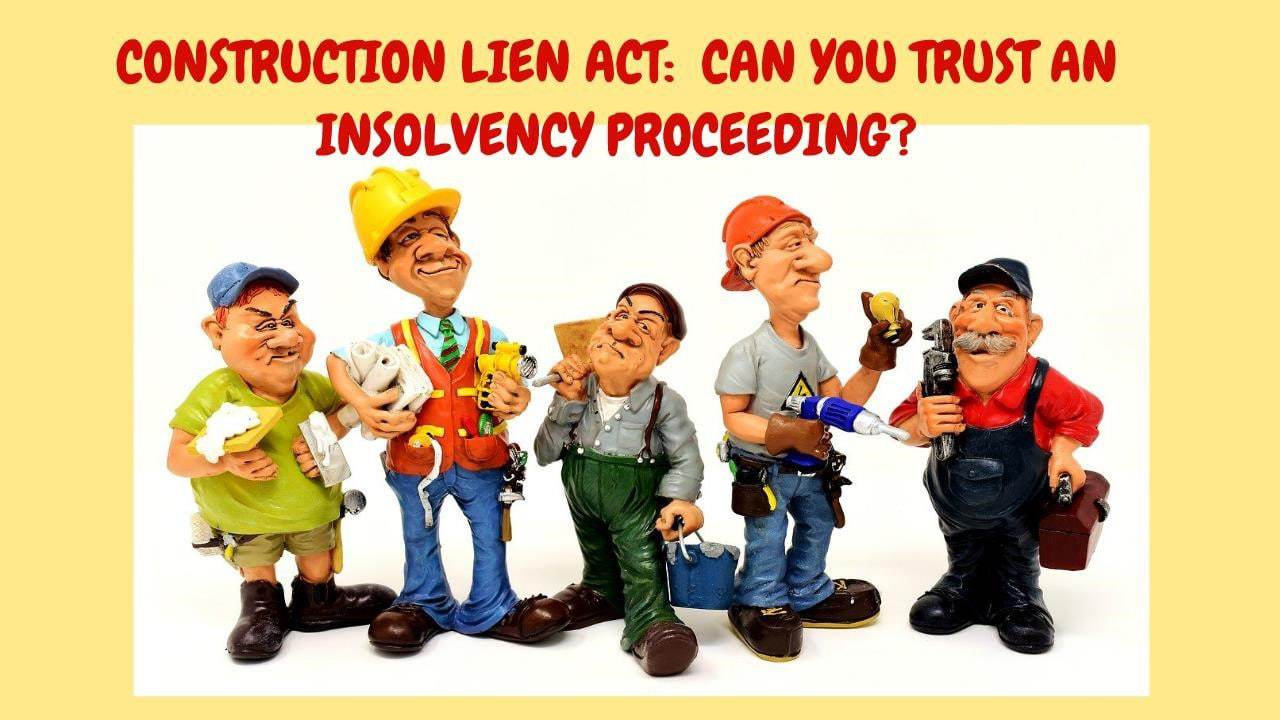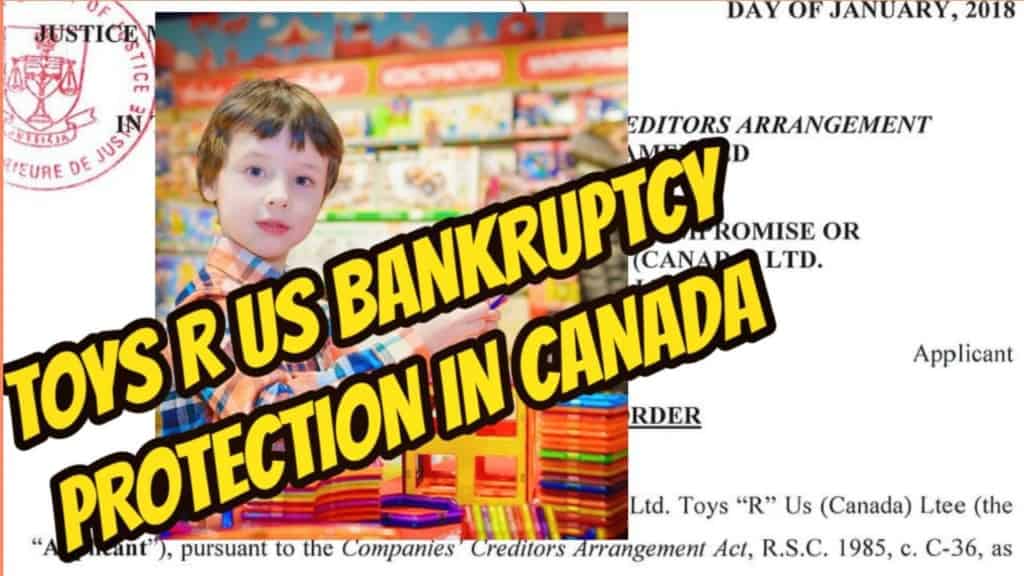The Ira Smith Team is absolutely operational and both Ira, as well as Brandon Smith, are right here for a telephone appointment, conference calls and also virtual meetings.
Stay healthy and safe everybody.
Introduction
Matters involving the Construction Act, R.S.O. 1990, c. C.30 ( formerly known as the Construction Lien Act) is very complex. In this Brandon’s Blog, I will use the term that laypeople are most familiar with, being the former name of the provincial legislation.
Construction law is a specialty unto itself. It gets even more complex when a company involved in construction enters insolvency proceedings. There is normally a conflict in these kinds of files between:
- the contractors who did work claiming a construction lien trust claim in the project;
- any secured creditors; and
- the licensed insolvency trustee (formerly called a bankruptcy trustee) administering the insolvency file.
In this Brandon’s Blog, I describe a recent 5 member panel decision of the Court of Appeal for Ontario who had to decide whether a trust created under section 9(1) of the provincial Construction Lien Act survives a sale by the Monitor in an insolvency proceeding under the federal Companies’ Creditors Arrangement Act (CCAA).
The case is Urbancorp Cumberland 2 GP Inc. (Re), 2020 ONCA 197 (Urbancorp). The matter was heard on October 3, 2019. The unanimous decision was recently released on March 11, 2020.
Some background matters
Before getting into the actual case, there are two background matters that I should first explain. When I thought of these concepts and then the decision this way, it made it easier for me to understand.
The first issue is the types of insolvency proceedings. There are essentially four types of insolvency proceedings. Some are not mutually exclusive. Each one of them can be used for the assets of the insolvent debtor to be sold. I break down the insolvency proceedings list in this way:
- Using the restructuring provisions of either the Bankruptcy and Insolvency Act (Canada) (BIA) or CCAA.
- A bankruptcy administration under the BIA.
- A secured creditor taking enforcement proceedings on the assets subject to its security through the security itself by privately appointing a Receiver or Receiver and Manager.
- A secured creditor making an application to the Court that it is just or convenient for the Court to appoint a Receiver to act on behalf of all creditors in stabilizing an insolvent debtor situation and to come back to Court with recommendations on how to proceed, including the sale of assets.
The second issue has to do with trust claims under the Construction Lien Act. There are several sections in the legislation dealing with trust claims. As I stated above, it is a very complex topic. So, I am going to only focus on the one that is the subject matter of this case. That is section 9(1) of the Act. That section deals with a trust claim against the vendor of the construction assets. It states:
“9 (1) Where the owner’s interest in a premises is sold by the owner, an amount equal to,
(a) the value of the consideration received by the owner as a result of the sale,
less,
(b) the reasonable expenses arising from the sale and the amount, if any, paid by the vendor to discharge any existing mortgage indebtedness on the premises,
constitutes a trust fund for the benefit of the contractor. R.S.O. 1990, c. C.30, s. 9 (1); 2017, c. 24, s. 9, 70.
Obligations as trustee
(2) The former owner is the trustee of the trust created by subsection (1), and shall not appropriate or convert any part of the trust property to the former owner’s own use or to any use inconsistent with the trust until the contractor is paid all amounts owed to the contractor that relate to the improvement. R.S.O. 1990, c. C.30, s. 9 (2).”
The distinction here that I want you to keep in mind is the words in the very first line “Where the owner’s interest in a premises is sold by the owner…”(emphasis added).
Now for the case.
The Urbancorp Construction Lien Act case
This case deals with Urbancorp and related companies that developed and was building a residential condominium project. Urbancorp was insolvent and filed first a Notice of Intention to Make A Proposal under the BIA. The proceedings were later converted by the Court into proceedings under the CCAA. The insolvency proceeding was in both cases under a Federal restructuring statue. The Court appointed a Monitor to oversee the insolvency administration. Through various Court applications and court orders, the Monitor was given the authority to market and sell the condominium assets. The Monitor did so.
Now the cash the Monitor received from the sale stood in place of the original condominium assets. Subcontractors brought an application before the lower Court claiming they had a valid trust claim under the Construction Lien Act. The lower court judge carefully reviewed the evidence and prior decided cases and came to the conclusion that the subcontractors did not have a valid trust claim against the assets. The subcontractors appealed the lower court’s decision.
In addition to appealing the lower court’s decision, they also raised with the Court of Appeal a constitutional question that comes up many times. The constitutional question is, does federal law always take priority, or trump (with a small “t”!!) provincial law. This is otherwise known as the concept of paramountcy. Stated slightly differently, the issue can be stated as does section 9 of the Construction Lien Act remain to have application after a bankruptcy or initial order under the CCAA? The Attorney General of Ontario also stepped in on that part of the case.
The Court of Appeal accepted this constitutional question to be decided so there were now two issues before the Court of Appeal; the issue of paramountcy and the trust claim issue.
The constitutional question
The Court of Appeal went through a very thoughtful and careful analysis. It confined the constitutional question to the facts of this case. The court concluded in this case:
- The trust created under section 9(1) of the Construction Lien Act is a valid trust under provincial law.
- The BIA excludes from property available to the creditors any property held in trust.
- Therefore, this provincial trust can be effective when there is an insolvency proceeding under the BIA.
- Similarly, with the CCAA legislation, it follows that a section 9(1) provincially created trust might be effective when the insolvency administration is subject to the CCAA.
Now for the actual appeal
The Appeal Court now turned to the lower court judge’s decision that a section 9(1) of the Construction Lien Act trust did not apply in this matter. The five-member panel again went through a careful analysis of the statute and the case law. They spent a lot of time reviewing an earlier Court of Appeal for Ontario decision which the lower court judge relied upon in his decision.
The Court of Appeal highlighted that in that decision the lower court relied upon, the owner, being the insolvent debtor, had no interest in the asset that the subcontractors were claiming a trust claim against. The reasons were:
- The asset was part of a package of assets sold.
- There was a secured creditor who had security over all of the assets of the developer.
- The proceeds less the expenses to produce the sale were less than what was owed to the secured creditor.
- The court allowed the cash from the sale to stand in place of the assets.
Using this framework, the Court of Appeal stated that a s.9( 1) trust only arises if the value of the consideration received by the owner from the sale of assets, which have actually been enhanced by the work or materials of the contractor, surpasses the amount of the mortgage debt. A trust will not occur if the value is zero, or if the mortgage debt is equal to or above any kind of sale proceeds.
Therefore, the decision that the lower court relied upon in disallowing the trust claim does not stand for the suggestion that control by a CCAA Monitor of a sales process, or the receipt by the Monitor of the proceeds of the sale by itself, avoids a s.9( 1) trust against the proceeds of the sale of the enhancement are shown to have a positive worth that surpasses the mortgage debt on the asset. That fact pattern was absent from the case relied upon.
The decision
Now, you remember at the beginning of this blog I went through the essentially four types of insolvency proceedings. The Court of Appeal also considered the various types. The court drew a distinction in them as it relates to section 9(1) of the Construction Lien Act. Also remember that from my quotation above of this section, it starts with “Where the owner’s interest in a premises is sold by the owner…”(emphasis added).
In a receivership or bankruptcy, the owner loses control of the assets. The vendor in a sale is either the receiver/receiver and manager or the trustee in bankruptcy, respectively. In those examples, it is not the owner selling its own assets. It is the licensed insolvency trustee (formerly known as a bankruptcy trustee) selling its right, title and interest, if any, in the assets of the debtor. So the vendor is the licensed insolvency trustee in its specific capacity.
The Urbancorp matter started out as a restructuring under the Proposal provisions of the BIA and was then converted by the Court and continued under a different restructuring statute, the CCAA. In an insolvency administration under the restructuring provisions/statue, the owner does not lose control of its assets. True that the Monitor is given court authority to make decisions, market and then sell the assets. However, one of the cornerstones of the appointment of a Monitor is that the owner does not lose control of the assets and the Monitor does not become the owner of the assets.
Rather, the Monitor gets its powers from the court. The Monitor is actually selling the insolvent company’s assets as the company’s representative or agent. So even though it is the Monitor doing the selling, it is doing so on behalf of the owner. This is very different than a sale by a receiver/receiver and manager or trustee in bankruptcy.
In the Urbancorp situation, the value of the consideration received by the owner from the sale of assets, which have actually been enhanced by the work or materials of the contractor, surpasses the amount of the mortgage debt.
Highlighting these distinctions, the Court of Appeal for Ontario overturned the lower court decision and upheld the subcontractors’ trust claim. It substituted the lower court decision with an order that a s.9( 1) trust under the Construction Lien Act applies for the sum of $3,864,429 held in the accounts of the Monitor on account of the Urbancorp companies, for the benefit of the subcontractors, pro-rata in accordance with the amount owing to each of them.
Summary
I hope you found this case review helpful. It should be of particular interest to contractors, developers and builders in Ontario.
The Ira Smith Team family hopes that you and your family members are remaining secure, healthy and well-balanced. Our hearts go out to every person that has been affected either via misfortune or inconvenience.
We all must help each other to stop the spread of the coronavirus. Social distancing and self-quarantining are sacrifices that are not optional. Families are literally separated from each other. We look forward to the time when life can return to something near to typical and we can all be together once again.
Ira Smith Trustee & Receiver Inc. has constantly used clean, safe and secure ways in our professional firm and we continue to do so.
Revenue and cash flow shortages are critical issues facing entrepreneurs and their companies and businesses. This is especially true these days.
If anyone needs our assistance, or you just need some answers for questions that are bothering you, feel confident that Ira or Brandon can still assist you. Telephone consultations and/or virtual conferences are readily available for anyone feeling the need to discuss their personal or company situation.
Are you now worried just how you or your business are going to survive? Those concerns are obviously on your mind. This pandemic situation has made everyone scared.
The Ira Smith Team understands these concerns. More significantly, we know the requirements of the business owner or the individual that has way too much financial debt. You are trying to manage these difficult financial problems and you are understandably anxious.
It is not your fault you can’t fix this problem on your own. The pandemic has thrown everyone a curveball. We have not been trained to deal with this. You have only been taught the old ways. The old ways do not work anymore. The Ira Smith Team makes use of new contemporary ways to get you out of your debt problems while avoiding bankruptcy. We can get you debt relief now.
We look at your whole circumstance and design a strategy that is as distinct as you are. We take the load off of your shoulders as part of the debt settlement strategy we will draft just for you.
We understand that people facing money problems require a lifeline. That is why we can establish a restructuring procedure for you and end the discomfort you feel.
Call us now for a no-cost consultation. We will listen to the unique issues facing you and provide you with practical and actionable ideas you can implement right away to end the pain points in your life, Starting Over, Starting Now.
The Ira Smith Team is absolutely operational and both Ira, as well as Brandon Smith, are right here for a telephone appointment, conference calls and also virtual meetings.






